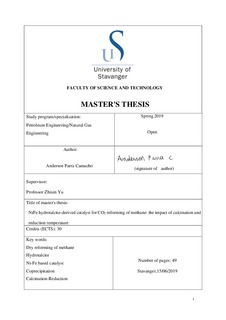| dc.contributor.advisor | Yu, Zhixin | |
| dc.contributor.author | Parra Camacho, Anderson | |
| dc.date.accessioned | 2019-12-19T12:57:05Z | |
| dc.date.available | 2019-12-19T12:57:05Z | |
| dc.date.issued | 2019-06-15 | |
| dc.identifier.uri | http://hdl.handle.net/11250/2634156 | |
| dc.description | Master's thesis in Petroleum engineering | nb_NO |
| dc.description.abstract | ABSTRACT
Carbon dioxide (CO2) emissions has become a major environmental concern for today’s society. As energy demand keeps on rising, the transition to cleaner energies is not fast enough to completely reduce greenhouse emissions. Therefore, new solutions must be found. Recently, several researches have been made on one possible solution. Dry reforming of methane (DRM) can utilize methane (CH4) and CO2 two of the most important greenhouse gases for producing valuable syngas as a chemical feedstock for industrial applications.
However, DRM process requires a heterogeneous catalyst for its operation and despite the efforts, a suitable catalyst viable from an economical point of view is yet to be found. Recently, studies on Ni-Fe based Hydrotalcite (HT)-derived compounds have presented promising results.
In this study a series of bimetallic Ni-Fe HT-derived catalysts with Ni loading of 20 wt.% and Fe/Ni molar ratio of 0.1 were prepared by coprecipitation at high supersaturation (fast injection method) and calcined at different temperatures. The catalysts were characterized by X-ray diffraction (XRD), nitrogen adsorption-desorption, temperature programmed reduction (TPR), and hydrogen chemisorption. The rise in calcination temperature generated an increase on crystallite size and reduction peak. On other hand, effects on surface area followed a bell tendency.
Calcined catalysts performance over activity and stability at different reduction temperatures were studied for a DRM reaction at a temperature of 700 °C, atmospheric pressure and a gas hourly space velocity (GHSV) of 120,000 mL.g-1.h-1. Calcination at 600 °C was found to be the overall best performer achieving the highest conversions with good signs of stability | nb_NO |
| dc.language.iso | eng | nb_NO |
| dc.publisher | University of Stavanger, Norway | nb_NO |
| dc.relation.ispartofseries | Masteroppgave/UIS-TN-IEP/2019; | |
| dc.subject | petroleumsteknologi | nb_NO |
| dc.subject | petroleum engineering | nb_NO |
| dc.subject | Hydrotalcite | nb_NO |
| dc.subject | Ni-Fe based catalyst | nb_NO |
| dc.subject | dry reforming of methane | nb_NO |
| dc.subject | coprecipitation | nb_NO |
| dc.subject | calcination-reduction | nb_NO |
| dc.title | NiFe hydrotalcite-derived catalyst for CO2 reforming of methane: the impact of calcination and reduction temperature | nb_NO |
| dc.type | Master thesis | nb_NO |
| dc.subject.nsi | VDP::Technology: 500::Rock and petroleum disciplines: 510::Petroleum engineering: 512 | nb_NO |
